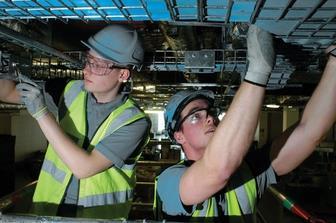More company apprenticeships would go a long way towards meeting the industry’s skills shortage, says Richard Plummer
The building and construction industry will need more than 80,000 new recruits a year from now until 2011, according to a recent Construction Skills Network report. While the economic climate may help to mask this looming skills shortage, it will not be the solution because the overriding challenge is not the quantity of recruits required but the quality.
A company’s most important asset is its people, and it is crucial to provide training to maintain and improve the skills base, which will ultimately enable clients’ needs to be met. Any forward-thinking organisation should offer workers the opportunity to learn and progress.
Apprenticeships provide a great opportunity to develop people within the culture of an organisation. Inviron recently took on 20 apprentices across the business, giving the company a total of 58 apprentices at various stages of training. They attend college, on day or block release, to learn construction theory and best practice and acquire technical and key skills certificates. At the same time they put their new skills into practice working alongside, and learning from, experienced Inviron staff.
One reason for the national skills shortage is unquestionably the limited number of companies taking on apprentices. In Suffolk alone there is an average of 250 apprentice applications each year and Inviron is able to offer places to only a small percentage of them.
Apprentices gain a variety of skills that allow them to grow in confidence, which leads to a desire for greater responsibility. Earlier this year one of our former apprentices, Jason Faulkner, travelled to the Antarctic to help test and inspect equipment at a research station.
Another factor in the skills shortage is the lack of information for would-be apprentices about how to enter the industry. Schools, colleges, training providers and the industry can solve this by working together more closely. Better information would encourage not only more applicants but also the right calibre.
There is a serious misconception among young people about how to get into the industry. Many believe that if they perform poorly at school they can default to an apprenticeship. This is not the case. We believe that only students with a minimum GCSE grade C in maths, English and science are able to cope with the demands. Far from discouraging applicants, dispelling this misperception would encourage better-quality candidates to come forward.
In summary, we need the support of schools, colleges, training providers and the industry to tackle two fundamental issues:
- providing school-leavers with good information about the industry to attract the right candidates for apprenticeship – this information should emphasise the diversity of the industry and career prospects, balanced by a clear message that apprenticeship is not an easy option;
- ensuring there is a high standard of training facilities and training staff, with a curriculum that excites young people and encourages them to excel.
Source
�ڶ����� Sustainable Design
Postscript
Richard Plummer is director of building systems at M&E designer Inviron























No comments yet